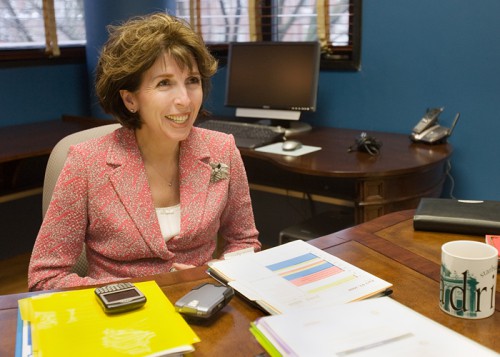
By Linda P.B. Katehi
Last year at the UC Davis Children’s Hospital, a two-year-old girl was admitted who was suffering from difficult-to-control and life-threatening epileptic seizures.
Her condition was grave. When she was put into a medically induced coma using general anesthesia, the customary treatment for a condition known as super-refractory status epilepticus, her blood pressure dropped to dangerously low levels.
The girl was given new medication developed, licensed and manufactured by a team of UC Davis researchers led by Dr. Michael Rogawski. Doctors said it seemed to be what allowed the anesthesia to be withdrawn and the girl’s life was saved. Today, she is reportedly doing well.
Rigorous clinical trials will determine the drug’s ultimate utility and effectiveness, but so far the results of Dr. Rogawski’s federally funded research have been extremely promising. A number of other young patients have responded favorably to it, including a 23-year-old male at Massachusetts General Hospital who had been in a medically induced coma for three months before the new treatment helped him recover. He, too, is now doing well.
As a Top Ten public research university, these are the types of breakthroughs UC Davis faculty, students and staff are constantly searching for. Much of our success in the laboratory can be traced back to an obscure 1980 law signed with little fanfare by then-President Jimmy Carter.
It’s known as the Bayh-Dole Act, named for the senators who sponsored it. President Carter might not have envisioned its full impact when he signed it into law. “I hope that this (law) will benefit the public in some measure by making the fruits of federally supported research and development more widely available,” he said in his understated signing message.
Undoubtedly, the impetus to explore potential commercial solutions to challenges like the one addressed by Dr. Rogawski and his team would be significantly reduced were it not for the landmark legislation.
Bayh-Dole allows universities and faculty researchers to own and license the intellectual property they develop with federally funded research. The law also gave research universities like UC Davis the responsibility for making sure intellectual property was developed for the public good.
Before Bayh-Dole, research supported by government agencies belonged solely to the federal government, which didn’t have the wherewithal or expertise to turn lab breakthroughs into commercial products.
Inspired Legislation
In 2002, The Economist magazine called the law “possibly the most inspired piece of legislation to be enacted in American over the past half-century,” along with amendments and follow-up measures a few years later. The magazine was not exaggerating.
The Economist reported that of 28,000 patents the federal government owned in 1980, fewer than five percent had been licensed to industry. Taxpayers were footing the bill for the research, but not getting much in return.
When the legislation was signed into law, the U.S. was in a deep economic slump. It was losing ground on the innovation front to Japan and Europe. With Congress looking for ways to revive the U.S. economy, Bayh-Dole was seen as a way for government research to result in new companies, products and jobs.
Soon after the law took effect, we started to see development of more sophisticated Offices of Technology Management on our campuses. We also saw a dramatic increase in research patents filed by U.S. universities. New ideas were spawned about the role Universities should play in advancing economic growth in our states, regions and nation.
Government-funded research and the universities’ ability to own intellectual property they created has laid the foundation for astonishing economic growth in the U.S. Although we can never afford to become complacent, our nation is once again recognized as the world’s leader in innovation.
Perhaps the most significant impact of Bayh-Dole was that it fostered development of an innovation ecosystem that has led to breakthroughs that have benefitted not only every American, but countless millions around the world.
Translating Basic Research into Products and Services is an integral part of the innovation process. And taking ideas to the marketplace leads to economic growth and an increase of wealth.
More UC Davis Startups
At UC Davis, we have worked hard to take better advantage of the research done on our campuses in Davis and in Sacramento. Last year, for example, UC Davis research helped launch 14 commercial startup companies, compared to eight the year before.
Among those startups was Tule Technologies, which is developing a monitoring system that allows growers to use water more efficiently. With California’s drought now in its fourth year, this could not be more timely.
Another startup this past year was Vivita Technologies, based in Davis. Vivita is creating biotech innovations that will boost the accessibility and reduce the cost of organ transplants.
There are many more. In total, 62 startups based on inventions originating at UC Davis have been formed since 2003, resulting in the creation of hundreds of high-value jobs in Davis and across our region. We’ve reported more than 200 inventions and have more than 500 plant licenses. UC Davis has almost 400 active U.S. patents and the university receives more than $12 million a year in licensing royalties from its research. Little of this would be possible without the Bayh-Dole Act.
To continue making progress, we must also acknowledge that the University’s participation in economic development faces distinct challenges even in the best of times and the best of circumstances.
Research breakthroughs can create tension in and among traditional intellectual communities. We must work to become more sophisticated and nimble when it comes to assigning precise ownership of intellectual property and in technology transfer.
We need to be more creative, more vigilant and more determined to rise to the challenge. Maintaining a vigorous and successful innovation ecosystem like the one America built after World War II, and again after Bayh-Dole, will require changes in how industry and academia interact. And the government must also continue to play a major role through its funding, policies and regulatory mechanisms.
Universities need well-articulated relationships with industry, while three-way public-private partnerships between academia, industry and government provide the means to sustain a healthy ecosystem for innovation.
We want to invent more life-saving drugs and medical breakthroughs. We want to discover better ways to solve engineering’s grand challenges such as cyber-security and environmental sustainability. We need research breakthroughs to feed and nourish a global population projected to reach 9 billion people by 2050.
Finding the best ways to preserve and enhance the innovation ecosystem sparked by Bayh-Dole is essential to our success.





Chancellor Katehi very eloquently lays out the positive aspects of public-private partnerships which of course is her job as representative of a major public research institute. What she does not mention is what this competitive, profits based approach costs. I do not pretend to know what it costs in fields other than medicine, so I will speak only to that field.
What this approach costs in the medical field are lives. If medications and processes that were in part developed with public monies were free ( or extremely low cost) and readily available to all this would not be true. However, what we have allowed to develop is a system in which are tax dollars are used to develop medicine and equipment that are then only available to us if we happen to be wealthy enough to pay out of pocket or if our insurance company will choose to pay which is frequently not the case. This is exacerbated since the federal government does not restrict or bargain for what fees pharmaceutical or medical equipment manufacturers can charge as other countries do. This effectively prices many out of life saving services available to citizens of other countries while maintaining the profit margins of pharmaceutical companies, medical equipment manufacturers, and insurance companies here. Although the ACA has expanded the number of people with access to health care, it has not in any way addressed the other excesses of the health care industry in protecting its profits.
It is my position that the benefits of publicly funded research should be available to all of the public, not just those fortunate enough to be at the top of the economic pyramid that is our country.
the problem is that without the profit motive, i don’t think you get the people willing to put forth the effort to do all of this.
Tia – I think you fail to understand and value the capital and effort required to take a public idea and bring it to market. Especially new drugs. I really see a great big blind spot in your reasoning related to these things.
The public can tax and spend as the alternative to investment of private capital for an expected return. In this the public side financing should reinvest the profit into the operation instead of paying returns to investors. However, what the public side business has proven over and over again is that it will just pay greater and greater dividends to the public side employees… thereby eroding any benefit that the reuse of the profit margin might have provided on paper. In addition, the public side approach lacks natural incentives to do things better, faster cheaper. So the costs increase at a steeper slope.
Private investment is the more efficient and effective method even as you and others lament the profit generated and wish you could get your mitts on it to give away in a never ending maternal obsession to take care of everyone.